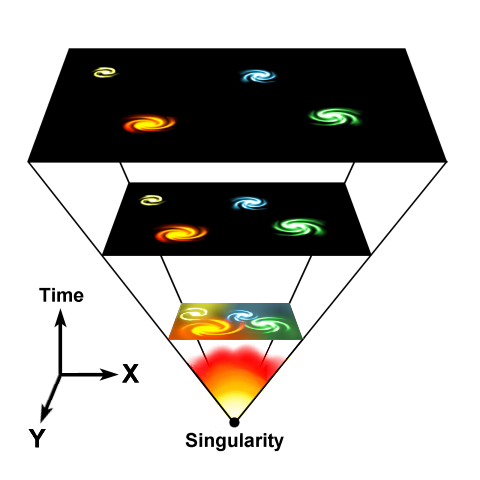Until 1998, we believed the universe was expanding at a steadily decreasing rate due to gravity, especially with the discovery of dark matter. Type Ia supernovae are believed to shine equally bright at their most luminous point and therefore can be used to determine distance. Observations of one such supernova determined the explosion occurred much further from Earth than what should have been possible if the universe was indeed decelerating its expansion. From this, it was determined that some force is countering gravity and causing the expansion to accelerate (expanding universe shown in Featured Image & Image 2). The cause of this has been attributed to dark energy, although not much is actually known about it or its properties.

Dark energy is not related to dark matter. The word “dark” in dark matter refers to the fact that we cannot observe it, whereas in dark energy it refers to the concept being mysterious and having an unknown source. Roughly 68% of the universe is thought to consist of dark energy, which is more than twice the amount of dark matter (27%). That leaves only 5% of the universe as baryonic matter – matter we can see.
There are a few possible ideas as to what dark energy is. Einstein had a theory called the cosmological constant which he created to oppose the influence of gravity under the assumption the universe was not expanding or contracting. When it was proven by Edwin Hubble that the universe was expanding, Einstein threw this part of his equations out. A similar concept to the cosmological constant that instead pushes for expansion rather than holding everything static may be the most likely theory as to what dark energy is.
Another popular theory is that there is an energy field or fluid that we haven’t discovered yet. This field or fluid, called quintessence, may be responsible for dark energy, provide it does exist.
Another idea is that Einstein’s Theory of General Relativity got it all wrong. So far, his ideas are holding under experimentation, so this seems the most unlikely of the three common explanations for dark energy.
In 2023, the European Space Agency plans to launch Euclid (artist’s interpretation in Image 3). This could give far more accurate measurements than what we currently have for the rate of expansion. It could also tell us what the jerk -the rate of change of the acceleration – is.
References
Briggs, A. (Mar 2020). “What is dark energy?” EarthSky. Retrieved Jun 2, 2022, from https://earthsky.org/space/definition-what-is-dark-energy/
“Dark Energy, Dark Matter.” (n.d.). NASA Science. Retrieved Jun 2, 2022, from https://science.nasa.gov/astrophysics/focus-areas/what-is-dark-energy
Department of Energy. (n.d.). “DOE Explains…Cosmic Acceleration and Dark Energy.” Department of Energy. Retrieved Jun 3, 2022, from https://www.energy.gov/science/doe-explainscosmic-acceleration-and-dark-energy
European Space Agency. (Jun 2020). “What is dark energy?” ESA Science & Technology. Retrieved Jun 3, 2022, from https://sci.esa.int/web/euclid/-/what-is-dark-energy-
Panek, R. (Apr 2010). “Dark Energy: The Biggest Mystery in the Universe.” Smithsonian Magazine. Retrieved Jun 3, 2022, from https://www.smithsonianmag.com/science-nature/dark-energy-the-biggest-mystery-in-the-universe-9482130/


